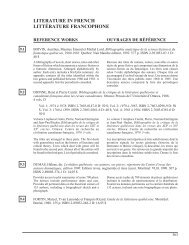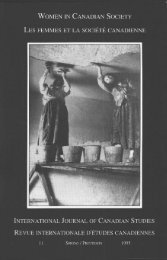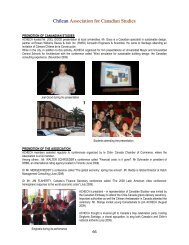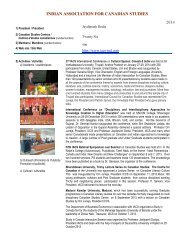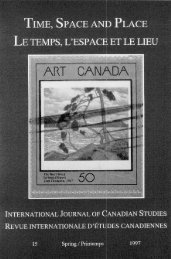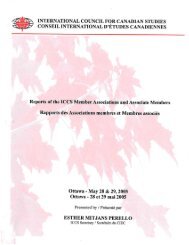Arts and Literature in Canada:Views from Abroad, Les arts et la ...
Arts and Literature in Canada:Views from Abroad, Les arts et la ...
Arts and Literature in Canada:Views from Abroad, Les arts et la ...
- No tags were found...
Create successful ePaper yourself
Turn your PDF publications into a flip-book with our unique Google optimized e-Paper software.
IJCS/RIÉCchanges perceptibly (<strong>from</strong> p<strong>la</strong><strong>in</strong>ness to sophistication) while register<strong>in</strong>g Del’ssteady growth towards fuller awareness.Christa Wolf’s structural concept marks a radical departure <strong>from</strong> theconventional first-person novel. The story of the adult woman’s journey to L.,the town of childhood (undertaken with husb<strong>and</strong>, brother <strong>and</strong> daughter), isconveyed <strong>in</strong> the second person, <strong>in</strong> a k<strong>in</strong>d of diary monologue. Every now <strong>and</strong>then the narrator has to check herself when confus<strong>in</strong>g the differentgrammatical forms applied to one <strong>and</strong> the same person: “But then you weresuddenly sitt<strong>in</strong>g—not you: the child Nelly—<strong>in</strong> your parents’ house [...]” (MC128, my emphasis). A third narratorial level, the here <strong>and</strong> now of the fictionalwriter (another version of “self,” both experienc<strong>in</strong>g <strong>and</strong> reflect<strong>in</strong>g over aperiod of some four years) is presented <strong>in</strong> the second person, too, but f<strong>in</strong>allyflows <strong>in</strong>to the first. Thus Christa Wolf signals, by means of a structural device,the f<strong>in</strong>al convergence of previously separate selves <strong>in</strong>to one identity.Throughout the novel, the three levels of narrative presentation are<strong>in</strong>tr<strong>in</strong>sically fused, so that the boundaries of time seem to melt, with the yearsof youth <strong>and</strong> the years of maturity gradually converg<strong>in</strong>g towards each other,chronological order be<strong>in</strong>g suspended.This strik<strong>in</strong>gly unconventional device of hold<strong>in</strong>g one’s “self,” as it were, atarm’s length for the purpose of a more truthful, more objective assessment isnot really as radical as it may appear. Christa Wolf has blurred the traces of aself both autobiographical <strong>and</strong> fictional by a conscious effort. Munro hasachieved the same result, so it seems, by a feat of <strong>in</strong>tuition. Her fictional, quasiautobiographicalfirst-person narrator, Del Jordan, puts <strong>in</strong> her first appearance<strong>in</strong> a number of stories preced<strong>in</strong>g Lives of Girls <strong>and</strong> Women, appears aga<strong>in</strong> (as anameless hero<strong>in</strong>e) <strong>in</strong> <strong>la</strong>ter stories such as “W<strong>in</strong>ter W<strong>in</strong>d” <strong>and</strong> “The OttawaValley” (collected <strong>in</strong> Som<strong>et</strong>h<strong>in</strong>g I’ve Been Mean<strong>in</strong>g to Tell You), to be f<strong>in</strong>allytransformed <strong>in</strong>to the third-person character Rose <strong>in</strong> the story sequence Who DoYou Th<strong>in</strong>k You Are?, 23 a cycle of third-person tales which, it can be argued, arestructurally conceived as first-person stories. Thus, Del Jordan, <strong>in</strong> travers<strong>in</strong>gsubstantial p<strong>arts</strong> of Munro’s fiction, 24 takes on forms of disguise that are assc<strong>in</strong>til<strong>la</strong>t<strong>in</strong>g <strong>and</strong> fasc<strong>in</strong>at<strong>in</strong>g as Wolf’s forms of camouf<strong>la</strong>ge conta<strong>in</strong>ed <strong>in</strong> as<strong>in</strong>gle novel, fictional portraits of one <strong>and</strong> the same person who is never quit<strong>et</strong>he same.The most strik<strong>in</strong>g correspondence b<strong>et</strong>ween the structures of the novelsK<strong>in</strong>dheitsmuster <strong>and</strong> Lives of Girls <strong>and</strong> Women, however, lies <strong>in</strong> the respectiv<strong>et</strong>reatments of memory material as a “generator” of narrative structure. Thus,the emerg<strong>in</strong>g writer Nelly Jordan raises the follow<strong>in</strong>g question:Does memory prefer to store anecdotes? Som<strong>et</strong>h<strong>in</strong>g about thestructure of memory seems to lend itself to a story with a po<strong>in</strong>t. (MC359, my emphasis)76



